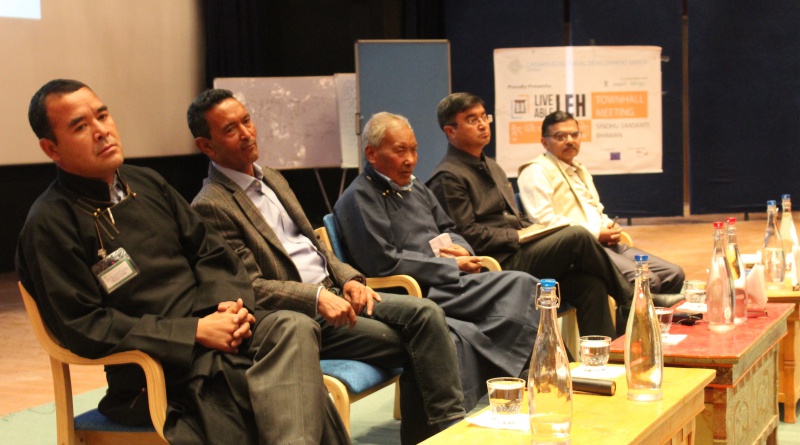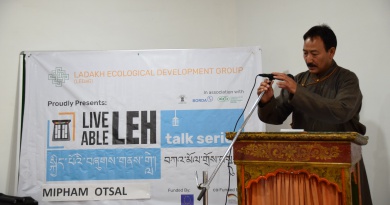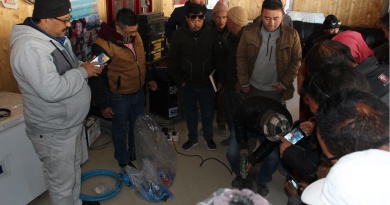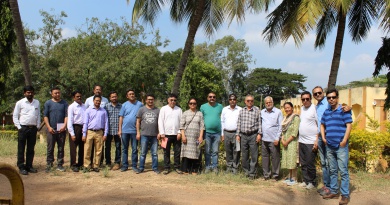Townhall meeting-Future of water in Leh
Activity: Town hall Meeting: ‘Future of Water in Leh-Where are we heading?’ Date: September 10, 2018 Location: Sindhu Sanskriti Bhawan, near Tisseru Participants: 301; excluding the guests, their entourage and LEDeG Staff
Guests Dorjey Mutup, Chief Executive Councillor, LAHDC; Nawang Rigzin Jora, Member of Legislative Assembly (MLA) Leh
- Objective:
to hold a participatory discussion on the water scenario in Leh and the steps that are required to overcome the water-related issues of the public
Summary Agenda:
Time Activity Person-in-charge 11:00 AM Overview of the Liveable Leh project Dr Nordan Otzer 11:10 AM Welcome speech Moses Kunzang, ADC 11:30 AM Water Scenario in Leh Manas Rath, BORDA 12:00 PM Learnings from Shimla Water story Tikender Panwar, ex-Deputy Mayor of Shimla 12:30 PM Chhurpon System: Revival Tsewang Dorjey Dongbos 12:50 PM Urbanisation and water-related issues in Leh Nawang Rigzin Jora 1:10 PM Discussion with the public/ Q&A Session 1:30 PM Address by the chair Dorjey Mutup, CEC LAHDC 1:45 PM Vote of thanks Dr Nordan Otzer
Summary of Results:
Additional District Commissioner Moses Kunzang
If we are to save water then we need a proper baseline study because people have no idea how much water is being consumed and supplied. We can quantify the problems faced by the people with the help of LAHDC and see what steps can be taken. But without proper data we can’t take any steps.
We should integrate traditional methods with modern technologies for conservation of water.
We assume that there are around 4,000 bore wells in Leh but it has not been quantified. We will start registration process for bore wells and also check how much groundwater we have so that necessary steps can be taken.
District Administration and LAHDC have taken up few projects:
1. Water Augmentation
a) Sewerage system: There are very few cities which have this type of system. We’re going to finalise it soon
b) STP: the tendering process has started and we are hopeful that it would be started soon
c) We have requested HIAL to conduct a study to understand the rate at which glaciers in Leh are receding, and also on the groundwater in Leh. They will send scientists for the same
d) Water bodies: There are lot of water bodies and we want to beautify and utilise it. Water also flows through the town and we want to utilise the traditional nullahs
e) We have identified few areas where we want to take up a pilot project and charge money for supply of water. We need to generate revenue and we will use the money on operation and maintenance.
f) We need technical staff on Municipal Committee. We cannot upgrade the municipality. We need back-hand office. Those who are coming up with new infrastructures will have to go through the municipality. We are thinking out-of-the-box to make municipality a working body. We need to strengthen the municipality.
g) Chhurpon system: Remuneration was the problem for the chhurpons and lora-pa. Now the administration is going to pay them for the revival of the Chhurpon system
1. Manas Rath, Senior Advisor, BORDA on Water scenario in Leh
We need to take positive steps so that there is not water scarcity in Leh for the next 30-40 years. It is not only the duty of the government to work for the conservation of water as the general public also need to join the cause
The population in Leh increased manifold post-2000 thereby putting more stress on the water resources of the town. The population of the tourists as well as locals increase in summers during which we need to cater to the needs of 1 lakh people. However, there is decrease in the number of locals in winters which make implementation of plans difficult
As per estimations, tourists need 100 litres of water per day, locals need 75 litres of water per day, whereas the workers/labourers need 30-40 litres of water per day. However, the maximum user of water is the locals who use 2.5 million litres per day.
As far as water sources are concerned, 0.4 MLD is lifted from springs, 2.1 MLD from Indus River, 2.4 MLD from tube wells within Leh and 2.6 MLD from private bore wells
The current supply of 4.9 MLD is provided by PHE department. Averaged daily supply of water is for two hours but almost 25-35% goes waste. There are 442 public stand posts (PSP) operational in leh town.
Managing bore wells: there is need to understand groundwater extraction, create a database of private bore wells, free water leads to wastage
New Indus River supply: water would be lifted from Choglamsar, which is 8km far from Leh and is 350m down. Maximum capacity post completion of project would be 12.7 MLD. There are 12 operational reservoirs (additional five reservoirs are currently under construction). It would have a distribution network of around 83km. It will cover more than 5,000 households, which is almost 90% of houses in Leh town, and provide direct water supply to homes. It would come at a cost of Rs 85 crore
New system status: 70% is complete, which stretches to 60km. It will be completed by 2019 and it will provide 4-24 hours of water supply
Some questions still need to be answered: 1. How to provide water supply in winter when the pipe freezes? 2. Who will be responsible for handover of household connections? 3. Who will take care of the cost of operations? 4. What about metering and pay-for-use?
Sewerage and wastewater: Sewerage system to be completed by 2020, STP of 3 MLD will be constructed and retreated water will be re-used, Blue Water Company treated 15 lakh litres of faecal sludge in the past year, septic tanks are of poor quality, protecting groundwater is critical
Reduce water wastage A. Infrastructure
New pipelines
Household connections, no PSPs
Check reservoirs
Good maintenance of system by PHE/MCL
Pipeline monitoring system B. Users
Use low water taps and flush (it will decrease wastage of water by 30-40%)
No showers (it will decrease wastage of water by 60-70%)
Low water washing machines/dish washers
On-site water treatment and re-use
Drip gardening/reduce number of poplar trees
Signs in hotel rooms
Water meters and differential pricing
NN Raina, PHE Department:
Augmentation of water scheme in progress. The construction has started and it will cost, as per DPR, Rs 70.5 crore
The peak capacity of water supply would be 135 litres per capita per day
Traditional water sources like springs will be developed, small check dams would be constructed and look to small nullahs to recharge groundwater
Instead of depending on groundwater, people should use surface water
Over-exploitation of water should be avoided
We have asked the government to implement rules to save water
Looking to revive ponds in town area not only for recharging groundwater but also for drinking
Tikender Singh Panwar: Shimla water story
Models adopted by Shimla I. 7 sources of water in Shimla II. 45 lakh tourists in Shimla per annum III. Two lakh residents
In 2005 a sewage treatment plant was constructed 5km above the water source which led to contamination of water. Every year there is an outburst of epidemic, such as hepatitis. Thousands of people were affected, some even died
Enforcement and monitoring very important
Solutions: Municipal Committee responsible for the distribution of the water whereas government would be responsible for the regulation of water
Greater Shimla Water Supply and Sewerage Circle (GSWSSC) was formed and every drop supplied to the public is the responsibility of GSWSSC. World Bank provided financial assistance of more than Rs 900 crore for water supply and sewerage project in Shimla
We need to build a system but the question is who will finance it? We need to be clear on this. If we spend Rs 100 and charge Rs 30 on the public then Rs 70 should be subsidy from the government.
The focus should be on surface water, not the groundwater
If we don’t take immediate steps then the J&K High Court will step in and issue order which cannot be over-ruled
Plastic bottled water and water purifiers are banned in Shimla; tap water is potable
There is a water body in Gangles, don’t neglect it. Instead of spending Rs 100 crore on a new project, it will cost just Rs 3-4 crore to run the existing project since it is gravity-run and gives one of the purest forms of water
Water contamination in upper parts of surface water bodies is significantly lower compared to lower reaches
Create a manual to lay pipes in order to avoid bursting of pipes in winter due to freezing
There is no liquidity parking in Leh, wealth is draining out of Leh
Tsewang Dorjey Dongbos: Chhurpon System in Leh-situation and revival
Leh was established 500 years back and the Chhurpon system also started with it which was spread all over Ladakh
The Chhurpon system was adopted where scarcity of water was high
Water from Gyamcha, Fughe and Nangche sources (either spring or glacier melt) were distributed on the way to fields through mayurs (major irrigation channels)
Eight people from different areas were selected for the post of Chhurpon and the election would take place at the Chenrezig monastery. Whoever wins would become the Churpon and he was responsible for making water available to every field in the village The churpon opens up channels from the stream to let water flow to different fields on different days. A family getting water goes to their fields to direct the water into smaller channels.
The importance of zings or reservoirs: water was stored and then supplied according to the needs of the people. There were seven reservoirs in Leh. However, Warzing was damaged in the 2010 floods in Leh
The distribution of water for irrigation of fields has been affected due to increase in population
As of now there are 17 Churpons in Leh, but the importance of Churpons have decreased over the years thereby leading people to leave lands barren and development of the same
The government has adopted many methods for beautification of Leh but the government should not neglect Churpons. Tourism has become the primary source of income for people but I appeal to the government and the administration to also work on the irrigation systems
What can be done to revive Churpon system? I. In the revenue record in Leh mappings are available. There is need to update the existing record II. Municipal Committee should be fully functional III. Restoration of irrigation systems, reservoirs are not being done in a proper way IV. There are some areas in which people own large lands. So, how much water the Churpon should provide to these huge lands? It is all given in the record
There were 13 ponds in Leh
Nawang Rigzin Jora:
Leh has always faced scarcity of water. It is due to climate change which we are experiencing through shortage of water and also through the flash flood in 2010. Now, glaciers are melting and receding. The reservoirs in which the glacier melt water was stored have been flooded and damaged. The precipitation pattern is changing and so we will continue to face such problems
Those who face problems will eventually come up with solutions and we will try to find solutions for the problems which we are facing One of such solutions is to revive the Churpon system. The social institutions in Leh are still intact and Churpon system is still prevalent in villages in areas around Leh.
Solutions: The water from Takmar area, which is on the right side of Khardung, can be lifted and used for irrigation in Leh. We can form a committee and work on the project to provide immediate relief from the shortage of water Farmers would have the major rights over the water
NHPC have submitted a visibility report
There is too much urbanisation and migration in Leh but we cannot stop it. So, it’s natural for the town to reel under the pressure
There has been decent flow of money in Leh town from the Centre but the onus is on us to ensure quality work in Leh. The locals must find solutions to overcome the shortage of water, like Sonam Wangchuk did. Due to his efforts, Phyang has become a model for everyone now.
The MGNREGA funds can be used for construction of ice-stupas. We should preserve traditional methods of water harvesting
There should be collective efforts from the government and the NGO’s for conservation of water
The politicians should not intervene if some good work is being carried out. Ladakh has young, dynamic leaders and we have the opportunity to improve or better the Municipality. We can make it a success.
Question and Answer Session/ Feedback:
Feedback: Sonam Wangchuk, Director HIAL:
We need to focus on urbanisation in Leh. There should be a license to spread tourism across Ladakh and not just keep it concentrated in Leh town only
The motto for Leh should be Reduce, Recharge and Re-freeze
The surface water flowing from nullahs is ten times the requirement of the people. We need check dams to utilise the surface water
Artificial glaciers are cheap compared to bore wells. The cost of artificial glacier is 1 paise per litre whereas the cost of the borewell is Rs 500 per litre, excluding the operation and maintenance (O&M) cost. In the summers we can use the water to recharge the groundwater and then we can freeze it in winters
We need to increase vegetation in Leh. There is just 0.06% natural vegetation in Leh. Need to promote seabuck thorn, etc
There is a need to revisit the policies. If we spread infrastructure across Leh then tourists will also distribute evenly across Leh
Question: There isn’t a single hand pump in the Khakshal area. I had requested bureaucrats and officers to look into the matter but nothing has been done in this regard?
Answer: Hand pumps comes under the provision of rural scheme whereas Leh falls in urban area scheme due to which hand pumps have not been put up. But the administration and LAHDC will look into the matter and identify some areas where hand pumps are a must.
Question: Most of the households in Leh town are entirely dependent on public supply pipes (PSP) and even the water they get is erratic. The district administration is talking about providing water to every household. How is that going to happen?
Answer: The project is currently in the process and we laying water pipes so that everyone has direct access to water. The work is going on in full swing and we are hopeful of completing the project soon. Once that is complete every household will have direct access to water which we are going to lift from Indus River.
8. Dorjey Mutup, Chief Executive Councillor:
There should a policy on conservation of Indus River. There is rampant construction on the marshy area of Indus River which could lead to contamination of the river. So, there is an urgent need of a policy on water
Discussion is very important and the key to finding solutions
The two main concerns are: A. Irrigation, B. Drinking Water Supply A Rs 70-crore project is in the pipeline, out of which Rs 40 crore has already been spent
We are hopeful that water will reach every house in leh town
There are flows in the functioning of the government. Money is sanctioned very late which affects work. But we promise to work for better supply of water in Leh
Usage of drinking water: Everyone should have access to water and it is our responsibility to ensure that. We should use water judiciously. I request the public not to waste water and use it according to their needs
Thankful to Tikender Panwar for opening us to new ideas. I appeal to the Administration to welcome and incorporate his ideas
If the Khardung La tunnel is completed, it will not only ensure smooth flow of traffic but also bring water to Leh.
We must highlight the water success stories in Leh. There are hotels which use wastewater from kitchens to irrigate the plant



